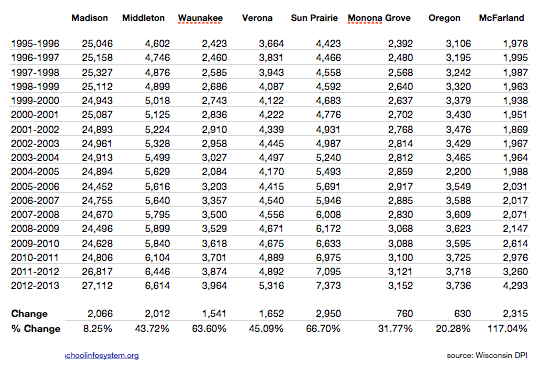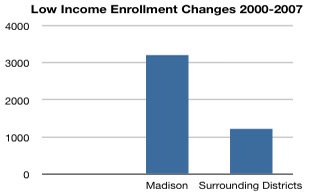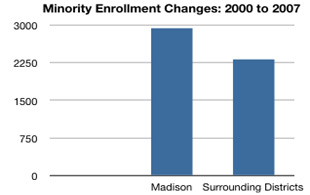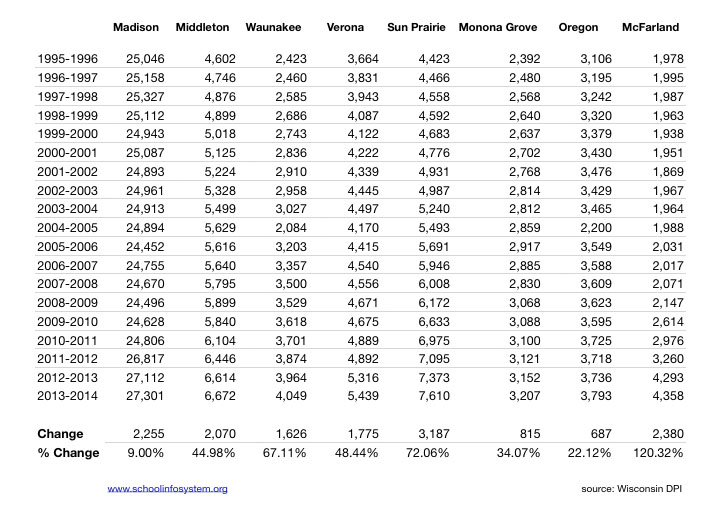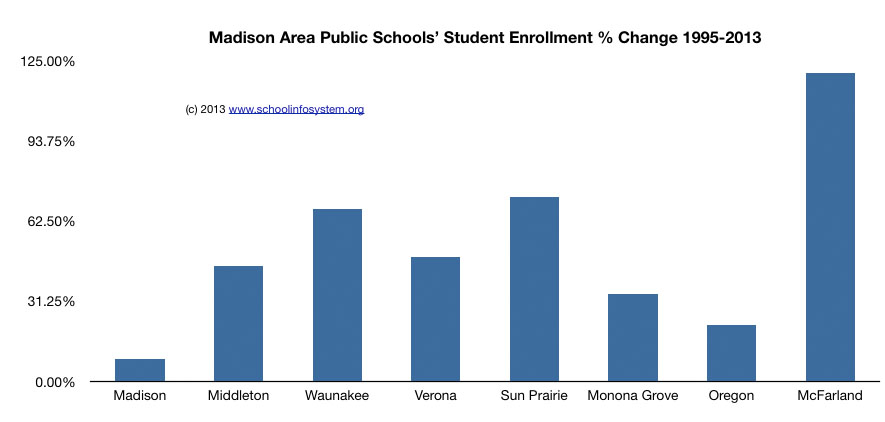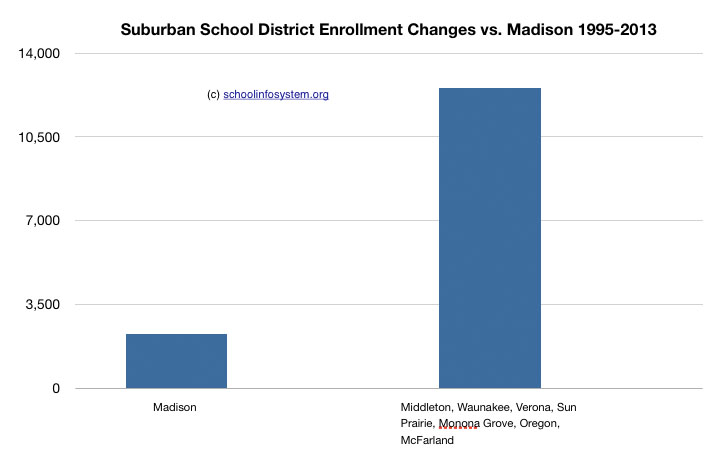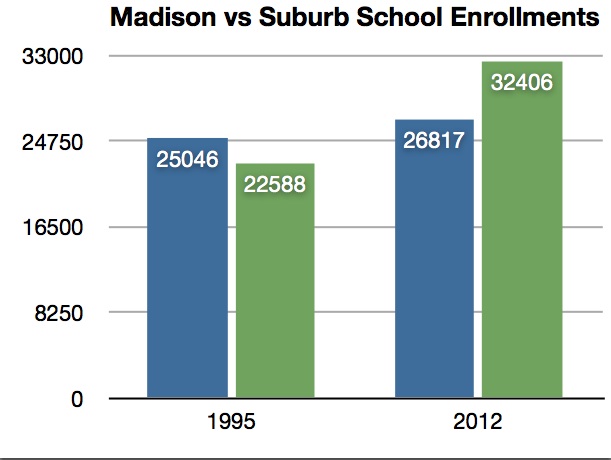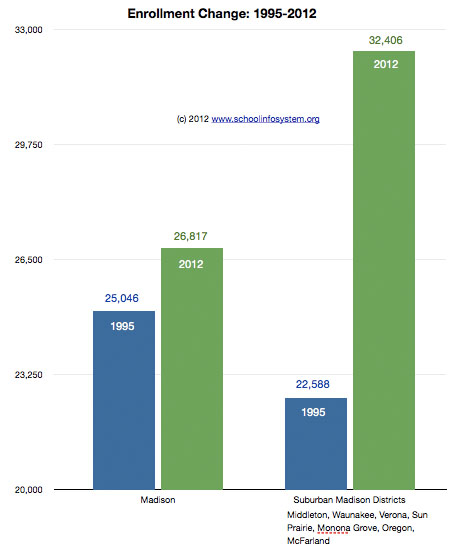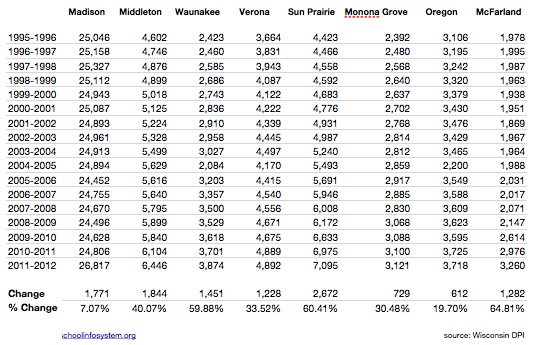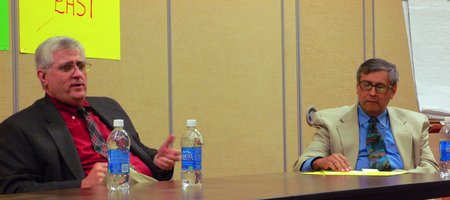Search Results for: "Where have all the students gone"
Where Have All The Students Gone? 1995-2024
More on suburban enrollment growth xlsx data
Where Have all the Students Gone? 1995 – 2019 Madison and nearby School Districts
Much more on Madison and nearby taxpayer supported K-12 school districts, here. Related: Outbound Open Enrollment “The data clearly indicate that being able to read is not a requirement for graduation at (Madison) East, especially if you are black or Hispanic” 2013: “What will be different, this time?”
Madison Student Enrollment Projections and where have all the students gone?
Madison School District PDF: Executive Summary: As part of its long-range facility planning efforts, MMSD requires a refined approach for predicting enrollment arising from new development and changes in enrollment within existing developed areas. As urban development approaches the outer edges of the District’s boundary, and as redevelopment becomes an increasingly important source of new […]
Where Have all the Students Gone? Madison Area School District Enrollment Changes: 1995-2013
Related: 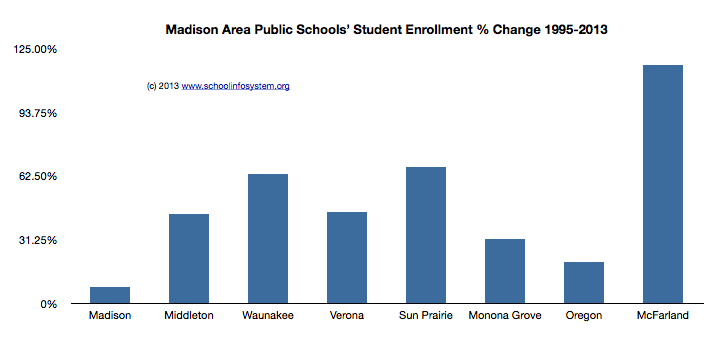
Where Have all the Students Gone? An Update
An update to Barb Schrank’s November, 2005 post:
Comments from a reader:
At $6,000 per child that’s about $16 million per year. At $9,000 per child, that’s about $23 million per year. If we kept 332, that would be $2-3 million more per year.
Also, MMSD not only lost students, which has a negative effect on what the district gets under revenue caps, we’ve increased our low-income population, which means that for every dollar the district gets, more of those dollars need to be spent on non-instructional services.
If the district does not consider the economic development implications of its decisions, we’re likely to
- see more go to school outside MMSD, or
- for the non-low income students who go to school here increased family dollars will be spent on private aspects of education- lessons, tutoring, etc.
Madison’s population in 2000 was 208,054 and is estimated to be 223,389, according to the census bureau. Madison’s poverty rate is estimated to be 13%, according to the Small Area Estimates Branch [Website].
District Enrollment
2000-2001Enrollment
2006-2007Per Student Spending (06/07 Budget) Administrators Total Staff ACT % Tested (05-06) ACT Comp Score Madison 25,087 24,755 $12,422 91.5 3544.6 61.1 24.2 Verona 4222 4540 $12,113 22 603.4 69.6 23.6 Middleton-Cross Plains 5125 5640 $12,822 21 756.3 73 24.5 Waunakee 2836 3357 $11,987 14 427.6 70.7 23.3 Sun Priarie 4776 5946 $11,238 20 741.3 62.6 23 McFarland 1951 2017 $11,853 9.5 251.2 64 23.7 Monona Grove 2702 2885 $12,289 13 388 71.4 22.6 Oregon 3430 3588 $11,572 15 465.1 59.2 23.2 Data sources:
- Wisconsin Department of Public Instruction
- Wisconsin School District Poverty Estimates (2005)
- WISTAX SchoolFacts07
Thanks to a number of readers for the updated information.
Where Have All the Students Gone?
Additional Charts: Enrollment Changes, Number of Minority Students | Enrollment Changes, Low IncomeMMSD Lost 174 Students While the Surrounding School Districts Increased by 1,462 Students Over Four School Years. Revenue Value of 1,462 Students – $13.16 Million Per Year* MMSD reports that student population is declining. From the 2000-2001 school year through the 2003-2004 school […]
The Persistent Economic Advantage of America’s Suburbs
Richard Florida: The rise of the city and the decline of the suburbs has emerged as a common meme in recent years. The young, the educated, and the affluent have come streaming back to the urban core, driving up rents, driving out the poor, and giving rise to patterns of gentrification. The story goes that […]
K-12 Tax & Spending Climate: Suburbs vs. Urban Markets
Joel Kotkin: Some suggest that the trends of the first decade of this century already are passé, and that more Americans are becoming born-again urbanistas. Yet after a brief period of slightly more rapid urban growth immediately following the recession, U.S. suburban growth rates began to again surpass those of urban cores. An analysis by […]
Are our suburban heads in the sand?
Erika Sanzi: Parents prefer relationships to data. Most of us enjoy people more than numbers and like parent teacher conferences better than bar graphs. We take comfort in knowing that our kids are being educated in a safe space and worry very little about the high school profile or SAT participation rate in our town. […]
March of Milwaukee students to suburban schools hits 8,000
Alan Borsuk: Every school day, more than 8,000 children who live in the city of Milwaukee head off to school in Milwaukee suburbs. I think of that as the equivalent of, say, six high schools or 16 elementary schools that are serving Milwaukee kids outside the city lines. That has a lot of impact, even […]
Property Tax Increase Climate: Madison’s Proposed 2015 Spending Referendum
A variety of notes and links on the planned 2015 Madison School District Property Tax Increase referendum: Madison Schools’ PDF Slides on the proposed projects. Ironically, Madison has long supported a wide variation in low income distribution across its schools. This further expenditure sustains the substantial variation, from Hamilton’s 18% low income population to Black […]
Trial Balloon on Raising Madison’s Property Taxes via another School Referendum? Homeowners compare communities…..
Molly Beck There’s been little movement since mid-March when Madison School District Superintendent Jennifer Cheatham proposed asking voters in November for $39.5 million in borrowing to upgrade facilities and address crowding. The proposed referendum’s annual impact on property taxes on a $200,000 Madison home could range from $32 to $44, according to the district. After […]
Madison School Climate, Achievement, Rhetoric & The New Superintendent
In light of Alan Borsuk’s positive article, I thought it timely understand the mountain to be climbed by our traditional $15k/student public school district. The charts above are a brief update of the always useful “Where have all the Students Gone” articles.
Further, early tenure cheerleading is not a new subject. Those interested might dive into the Capital Times & Wisconsin State Journal Superintendent (recently easily searched, now rather difficult) archive:
Cheryl Wilhoyte (1,569) SIS
Art Rainwater (2,124) SIS
Dan Nerad (275) SIS
That being said, Superintendent Cheatham’s comments are worth following:Cheatham’s ideas for change don’t involve redoing structure. “I’d rather stick with an imperfect structure,” she said, and stay focused on the heart of her vision: building up the quality and effectiveness of teaching.
Improving teaching is the approach that will have the biggest impact on the gaps, she said.
“The heart of the endeavor is good teaching for all kids,” Cheatham said in an interview. Madison, she said, has not defined what good teaching is and it needs to focus on that. It’s not just compliance with directives, she said.Perhaps the State Journal’s new K-12 reporter might dive into what is actually happening in the schools.
Related: Madison’s long term disastrous reading results and “When all third graders read at grade level or beyond by the end of the year, the achievement gap will be closed…and not before“.
“The notion that parents inherently know what school is best for their kids is an example of conservative magical thinking.”; “For whatever reason, parents as a group tend to undervalue the benefits of diversity in the public schools….”
Where have all the students gone?
Madison School Board President Ed Hughes:Esenberg sets out to identify the fundamental differences between voucher advocates and opponents. His thesis is that views on vouchers derive from deeper beliefs than objective assessments of how well voucher schools perform or concerns about vouchers draining funds from public schools. To him, your take on vouchers depends on how you view the world.
Esenberg asserts that voucher advocates are united by their embrace of three fundamental principles: that a centralized authority is unlikely to be able to decide what is best for all; that families should be trusted to select their children’s schools since ordinary people are capable of making choices for themselves without paternalistic direction; and that “government does not do diversity, experimentation and choice very well.”
By implication, he asserts that voucher opponents think that a centralized authority will be able to decide what’s best for all, that families shouldn’t be trusted to make choices for their children, and that government control is the best way to foster innovation.
And there you have it. Your views on school voucher expansion are entirely explained by whether you prefer individual freedom, like the voucher advocates, or stultifying government control, like the voucher opponents. In cinematic terms, voucher opponents are the legions of lifeless, gray drones in Apple’s famous 1984 commercial and voucher supporters are the colorful rebel, bravely challenging the control of Big Brother and hurling her sledgehammer to smash mindless conformity. You couldn’t ask for a more sophisticated analysis than that, could you?
While his thesis invites mockery, Esenberg’s short article does present a bit of a challenge to voucher opponents like myself. Can we set out a coherent justification for our opposition that doesn’t depend on the facts that voucher schools drain needed resources from public schools and don’t perform any better? Sweeping those fairly compelling points aside, Esenberg asks, in effect, what else you got?Mr Hughes anti-voucher rhetoric is fascinating on several levels:
1. The Madison School District’s long term, disastrous reading results. How much time and money has been wasted on anti-voucher rhetoric? Reading has long been job one.
2. Local private schools do not have much, if any availability.
3. Madison spends double the national average per student (some of which has been spent on program explosion). Compare Milwaukee Public and Voucher Schools’ Per Student Spending.
4. Madison’s inability to address its long-term disastrous reading results will bring changes from State or Federal legislation or via litigation.
5. Superintendent Cheatham cited Long Beach and Boston as urban districts that have “narrowed the achievement gap”. Both districts offer a variety of school governance models, which is quite different than Madison’s long-time “one size fits all approach”.
I recall being astonished that previous Madison School District administrators planned to spend time lobbying at the State level for this or that change – while “Rome is burning“. Ironically, Superintendent Cheatham recently said:“Rather than do a lot of work on opposing the voucher movement, we are going to focus on making sure our schools are the best schools possible and the schools of choice in Madison,” Cheatham said.
This points up one of the frustrating aspects of trying to follow school issues in Madison: the recurring feeling that a quoted speaker – and it can be someone from the administration, or MTI, or the occasional school board member – believes that the audience for an assertion is composed entirely of idiots.
A great, salient quote. I would hope that the District would focus completely on the matter at hand, disastrous reading scores. Taking care of that problem – and we have the resources to do so – will solve lots of other atmospheric and perception issues.
In closing, I sense politics in the voucher (and anti-open enrollment) rhetoric. Two Madison School Board seats will be on the Spring, 2014 ballot. One is currently occupied by Mr. Hughes, the other by Marj Passman. In addition, local politics play a role in becoming school board President.
Commentary on Wisconsin’s Proposed Voucher and Charter School Expansion
Stop the latest ploy by the WIGOP to destroy our public schools!The time to act is now: bit.ly/18zyVJW
— Madison Teachers Inc (@MtiMadison) May 30, 2013
Long term disastrous reading scores are the existential threat to our local public school “status quo” structure.
Related: Where Have all the Students Gone? Madison Area School District Enrollment Changes: 1995-2013.
“We are not interested in the development of new charter schools”
Larry Winkler kindly emailed the chart pictured above.
Where have all the Students gone?
Madison Mayor Paul Soglin:We are not interested in the development of new charter schools. Recent presentations of charter school programs indicate that most of them do not perform to the level of Madison public schools. I have come to three conclusions about charter schools. First, the national evidence is clear overall, charter schools do not perform as well as traditional public schools. Second where charter schools have shown improvement, generally they have not reached the level of success of Madison schools. Third, if our objective is to improve overall educational performance, we should try proven methods that elevate the entire district not just the students in charter schools. The performance of non-charter students in cities like Milwaukee and Chicago is dismal.
In addition, it seems inappropriate to use resources to develop charter schools when we have not explored system-wide programming that focuses on improving attendance, the longer school day, greater parental involvement and combating hunger and trauma.
We must get a better understanding of the meaning of ‘achievement gap.’ A school in another system may have made gains in ‘closing’ the achievement gap, but that does not mean its students are performing better than Madison students. In addition, there is mounting evidence that a significant portion of the ‘achievement gap’ is the result of students transferring to Madison from poorly performing districts. If that is the case, we should be developing immersion programs designed for their needs rather than mimicking charter school programs that are more expensive, produce inadequate results, and fail to recognize the needs of all students.
It should be noted that not only do the charter schools have questionable results but they leave the rest of the district in shambles. Chicago and Milwaukee are two systems that invested heavily in charter schools and are systems where overall performance is unacceptable.Related links:
- Notes and links on the rejected Madison Preparatory Academy IB Charter School. [Kaleem Caire video interview]
- Comparing Milwaukee Public and Voucher Schools’ Per Student Spending
- When all third graders read at grade level or beyond by the end of the year, the achievement gap will be closed…and not before (2005)
- “They’re all rich, white kids and they’ll do just fine” — NOT!
- Paul Soglin notes and links.
- Madison School District Open Enrollment Leavers Report, 2012-13 (2009 Open Enrollment Leaver Survey)
- Paul Vallas visits Madison; Enrollment Growth: Suburban Districts vs. Madison 1995-2012
- Where does MMSD get its numbers from?
- 60% to 42%: Madison School District’s Reading Recovery Effectiveness Lags “National Average”: Administration seeks to continue its use
- Minneapolis teacher’s union approved to authorize charter schools
I am unaware of Madison School District achievement data comparing transfer student performance. I will email the Madison School Board and see what might be discovered.
Pat Schnieder:Madison Mayor Paul Soglin has some pretty strong ideas about how to improve academic achievement by Madison school children. Charter schools are not among them.
In fact, Madison’s ongoing debate over whether a charter school is the key to boosting academic achievement among students of color in the Madison Metropolitan School District is distracting the community from making progress, Soglin told me.
He attended part of a conference last week sponsored by the Urban League of Greater Madison that he says overstated the successes elsewhere of charter schools, like the Urban League’s controversial proposed Madison Preparatory Academy that was rejected by the Madison School Board a year ago.
“A number of people I talked with about it over the weekend said the same thing: This debate over charter schools is taking us away from any real improvement,” Soglin said.
Can a new committee that Soglin created — bringing together representatives from the school district, city and county — be one way to make real progress?The City of Madison’s Education Committee, via a kind reader’s email. Members include: Arlene Silveira, Astra Iheukemere, Carousel Andrea S. Bayrd, Erik Kass, Jenni Dye, Matthew Phair, Maya Cole and Shiva Bidar-Sielaff.
Paul Vallas visits Madison; Enrollment Growth: Suburban Districts vs. Madison 1995-2012
Related:
- Where Have All the Students Gone (November, 2005)?
- Where Have all the Students Gone? An Update (January, 2008)
- Madison School District Outbound Open Enrollment.
- Open Enrollment Leavers Survey
Paul Vallas will be speaking at Madison LaFollette high school on Saturday, May 26, 2012 at 1:00p.m. More information, here.
Much more on Paul Vallas, here.
Directions.
Per Student Spending:
I don’t believe spending is the issue. Madison spends $14,858.40/student (2011-2012 budget)
Middleton’s 2011-2012 budget: $87,676,611 for 6,421 students = $13,654.67/student, about 8% less than Madison.
Waunakee spends $12,953.81/student about 13% less than Madison.
A few useful links over the past decade:
- Notes and links on Madison Superintendent hires since 1992 (2007).
- English 10
- Small Learning Communities
- Connected Math
- Reading Recovery
- When all third graders read at grade level or beyond by the end of the year, the achievement gap will be closed…and not before
- Madison School Board member may seek audit of how 2005 maintenance referendum dollars were spent
- Madison Preparatory Academy
Annual Enrollment Report- School Enrollments and Capacities 2010
The first attachment is a one-page overview summary of the past five years of enrollment history, the current year enrollment, and five years of projected enrollment by grade level. Overall, enrollment is generally flat for the district as a whole. However, enrollment has increased slightly for the past two (2) years. We project that this increase will continue for the next two years through 2012-13. After 2012-13 District overall enrollment K-12 will begin to decline slightly. Overall District enrollment has been remarkably stable since 1992 (minimum= 23,556 in 1992, maximum= 24,962 in 1998, average of 24,426 over the past 20 years.
By level, we project that only middle schools will continue to see increases in enrollment during the next five years whereas high and elementary schools will decline in enrollment. Elementary enrollments five years out are based largely on births 5 years prior. Births were at historical highs from 2004 to 2007 (over 3100 births in the City of Madison in each of those years, the highest since the mid 1960’s). Births declined in 2008 (-8%) and 2009 (-13%) respectively from the 2007 high.
The second attachment shows the detailed K-12 enrollment history and projections for each school. Actual enrollment is displayed for 2006 to 2011. Projections are through 2015-16. Projection years are boldfaced. The precision of projections at a school level and for specific grade levels within a school are less accurate when compared to the district as a whole. Furthermore, projections are much less reliable for later years in the projection timeline. Also, the worksheet reflects various program and boundary changes that were implemented and this accounts for some large shifts within schools and programs from one year to the next.Related: 11/2005: Where Have all The Students Gone, and Dane County Population Trends: 1990 –.
Madison Schools enrollment remains steady at 24,622
via a Madison School District email:
Student enrollment in the Madison Metropolitan School District for the 2009-10 school year is up 82 students to 24,622 according to the official enrollment count conducted on the third Friday in September, as required by state law.
The 82 student rise over last year’s official enrollment count of 24,540 represents an increase of one third of one percent (0.33%).
Enrollment in Madison Schools has been remarkably consistent. This is the ninth straight year that MMSD enrollment has been between 24 and 25-thousand students.
Of note is the increase in the number of kindergarten students enrolled in Madison Schools. The count of 2,146 kindergarten students is:
- 140 students above last year’s number (2,006);
- the highest enrollment for that grade level in the last 15 years;
- nearly four percent greater than the most recent projection (80 students above 2,066 projection).
For more information on kindergarten-12th grade enrollment, go to http://infosvcweb.madison.k12.wi.us/stats
Related: “Where have all the students gone?” The student population drives a school district’s tax & spending authority.
Madison’s Population Grew 22,491 from 2000 to 2008, School Enrollment Flat
Madison continued its remarkable population surge with a 10.7% increase from 2000 to 2008, top among Wisconsin cities with a population of 50,000 or more. The capital also led Wisconsin in numerical growth, adding 22,491 people, for a total population of 231,916.
“Madison remains a very desirable place to live, and positive growth rates like this reflect that high quality of life,” Madison Mayor Dave Cieslewicz said in a statement.
The new estimates are intriguing, both locally and nationally, because they detail America’s population at the cusp of the financial meltdown and in the midst of a housing bust. They’re also the last estimates to be released before the 2010 census is taken.
“Big cities are resilient,” said William H. Frey, a demographer with the Brookings Institution in Washington, D.C. “They’ve been able to survive in a very difficult economy. These cities have diverse economies that can hold their own in these troubled times.”Related:
- Where have all the students gone?
- increased outbound open enrollment applications from the Madison School District
- A bit of historic enrollment and staffing data.
- Credit for Non-MMSD Classes
Madison’s enrollment was 24,758 during the 1999-2000 school year and 24,189 during the 2008-2009 academic year. More here and here.
Given Madison’s academic orientation (UW-Madison, MATC, Edgewood College, not to mention a number of nearby institutions), our students (every one of them) should have access to world class academics.
A Discussion on School Models (Traditional, Charter and Magnet)
Madison Superintendent Art Rainwater and Rafael Gomez held an interesting discussion on school models recently [Announcement].Read the transcript
Watch the Video
or listen to the event (41mb mp3 audio)
Related:
Where to Educate Your Child? Madison Area is #2
Via a reader’s email: David Savageau (Contributing Editor of Expansion Management Management):
Three out of 10 of us either work in an educational institution or learn in one. Education eats up 8% of the Gross National Product. Keeping it all going is the biggest line item on city budgets. Whether the results are worth it sometimes makes teachers and parents–and administrators and politicians–raise their voices and point fingers.
In the 1930s, the United States was fragmented into 130,000 school districts. After decades of consolidation, there are now fewer than 15,000. They range in size from hundreds that don’t actually operate schools–but bus children to other districts–to giants like the Los Angeles Unified District, with three-quarters of a million students.
Greater Chicago has 332 public school districts and 589 private schools within its eight counties. Metropolitan Los Angeles takes in 35 public library systems. Greater Denver counts 15 public and private colleges and universities. Moving into any of America’s metro areas means stepping into a thicket of school districts, library systems, private school options and public and private college and universities.Here are some of their top locations:
- Washington, DC – Arlington, VA
- Madison, WI
- Cambridge-Newton-Framingham
- Baltimore -Towson
- Akron, OH
- Columbus, OH
- Albany-Schenectady-Troy, NY
- Syracuse, NY
- St. Louis, MO
- Ann Arbor, MI
The Madison area has incredible resources for our children. The key of course, is leveraging that and being open to working effectively with many organizations, something Marc Eisen mentioned in his recent article. Madison’s new Superintendent has a tremendous opportunity to leverage the community from curricular, arts, sports, health/wellness, financial and volunteer perspectives.
Related:
- Where have all the students gone?
- Madison School District small learning community Grant application(s) and history.
- My Life and Times with the Madison Public Schools.
- Update on Credit for Non-MMSD Courses.
The Madison area, which includes all of Dane County as well as immediately adjoining areas, was awarded A+ for class size and spending per pupil in public schools, and for the popularity of the city’s public library.
The greater Madison area scored an A for being close to a college town and for offering college options.
Private school options in the greater Madison area were graded at B+.
There has been some confusion in the response to the rankings because they lump together numerous school districts — urban, suburban and rural.The engineering-based program is just one example of the district’s willingness to bring college-level learning to his high school students. That effort appears to be paying off nationally, WISC-TV reported.
“It reinforces that what we’re trying to do as a district and as an area is working,” said Granberg. “And it’s getting recognized on a national level, not just a local or state level.”
“This is not a community that accepts anything but the best and so that bar is always high,” said Madison Metropolitan School District Superintendent Art Rainwater.
Rainwater also credits the ranking to teacher development programs.
“We spend an awful amount of time and an awful amount of effort working with our teachers in terms of how they deliver instruction to individual children,” said Rainwater.
He said the school district will continue to improve techniques, focusing on the needs of every student.
Wingra School proves that progressive education works. Could it be a model for a public charter school?
Inside Wingra School, the day is just beginning, and already Lisa Kass is commandeering a discussion about violence sparked by storyboards written by her fourth- and fifth-grade students.
“Why do you play violent videogames?” she asks. “Do you think the violence affects you?” This leads to a 45-minute discussion that temporarily pushes back a math lesson.
“It’s cartoon violence, it’s not real violence,” says one boy. “Well, really the goal is to kill people,” admits another. That, says a third student, is why he plays mostly strategy videogames.
The students at Wingra are articulate, reflective and eager to share their opinions. They refine their thoughts as Kass prods them to be more specific or clearer.
Kass, a 19-year veteran Wingra teacher, says later: “I don’t want to censor them, but I want them to think about what’s appropriate and what effects violence might have on them and others.”Related:
Parents prove charter schools work
The magic of charter schools isn’t so much the innovation they strive to achieve. The magic is the effect these schools have on parents.
At the Nuestro Mundo charter school on Madison’s East Side, you have to win a lottery to get your child into the program. This is true even for parents like me who live just a few blocks from Allis Elementary School, where Nuestro Mundo (which means “Our World ” in Spanish) is housed.
Imagine that — parents flooding a city school with enrollment applications for their kids. This is the opposite trend that Madison fears and must avoid.
Though rarely discussed in a frank way, Madison is increasingly nervous about middle- to upper-income parents losing faith in city schools and moving to the suburbs. As so many Madison leaders love to say: “As the schools go, so goes the city. ” Madison doesn ‘t want to become Milwaukee.Related: Where have all the students gone?
Madison School Board Discussion of School Models, Including Basic and Alternative Approaches
The Madison School Board’s Performance and Achievement Committee recently discussed alternative education models. Watch the video here (or download the mp4 file via a CTRL Click. mp4 files can be played back on many portable media players such as iPods). Listen via this mp3 audio file.
Related:
I Just Couldn’t Sacrifice My Son
When a high school friend told me several years ago that he and his wife were leaving Washington’s Mount Pleasant neighborhood for Montgomery County, I snickered and murmured something about white flight. Progressives who traveled regularly to Cuba and Brazil, they wanted better schools for their children. I saw their decision as one more example of liberal hypocrisy.
I was childless then, but I have a 6-year-old now. And I know better. So to all the friends — most but not all of them white — whom I’ve chastised over the years for abandoning the District once their children reached school age:
I’m sorry. You were right. I was wrong.
After nearly 20 years in the city’s Takoma neighborhood, the last six in a century-old house that my wife and I thought we’d grow old in, we have forsaken the city for the suburbs.Related:
- Where Have All the Students Gone?
- This is Not Your Grandchild’s Madison School District
- Promises Betrayed
Megan McArdle has more.
“Politically Correct Trumps Substance Every Time”
Paul Soglin on Why the Prospects for Madison are so Bleak, Part II: “Struck by the number of residents who said if things don’t improve soon, they’ll consider moving elsewhere.” Good grief. Its been going on for over a decade and really picked up around 2000. The school enrollment figures clearly show that. And go […]
Denver’s Attempt to Address Their “Enrollment Gap”
Superintendent Michael Bennet and the Denver School Board: The Rocky Mountain News series, “Leaving to Learn [Denver Public Schools Enrollment Gap],” tells a painful and accurate story about the state of our school district. It is hard to admit, but it is abundantly clear that we will fail the vast majority of children in Denver […]
Madison Schools, New Population, New Challenges
Sandy Cullen: Twenty-five years ago, less than 10 percent of the district’s students were minorities and relatively few lived in poverty. Today, there are almost as many minority students as white, and nearly 40 percent of all students are considered poor – many of them minority students. And the number of students who aren’t native […]
